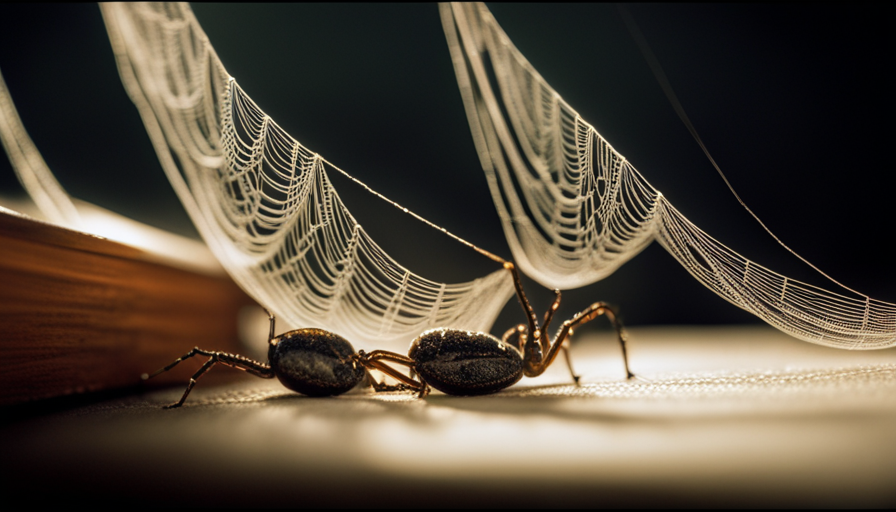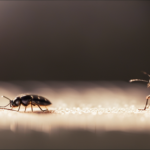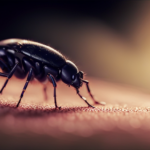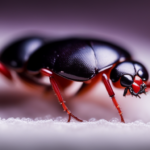At home, a feeling of unease creeps up on me as tiny black pests invade every nook and cranny. They scurry across my kitchen counters, cling to my curtains, and seem to multiply rapidly. It’s like a scene from a horror movie, with these small creatures taking over my safe haven.
If you’re experiencing a similar nightmare, fear not, for I have embarked on a quest for answers. In this article, we will delve into the world of these pesky black bugs, seeking to identify their species and understand their behavior. We will uncover the source of their infestation, exploring the dark corners they call home.
But fear not, my fellow bug-battler, for I have also discovered the secrets to combating these intruders. We will explore preventive measures to keep them at bay, from removing their food sources to utilizing natural remedies. We will uncover the importance of cleanliness and regular vacuuming, as these bugs thrive in filth.
So join me on this journey, as we arm ourselves with knowledge and reclaim our homes from these tiny black menaces. Together, we will restore peace and tranquility to our once bug-free abodes.
Key Takeaways
- Identifying the type of bug is crucial for determining the best course of action to get rid of them.
- Natural remedies, such as essential oils and vinegar, can be used to repel or kill the bugs.
- Regular cleaning, sealing entry points, and removing attractants are effective preventive measures to keep bugs at bay.
- If the infestation is severe or persists, professional pest control services may be necessary for long-term solutions.
Identify the Type of Bug
I’ve got these tiny little black bugs crawling all over my house, and I’m trying to figure out what type they are. It’s important to identify the type of bug in order to determine the best course of action for getting rid of them.
There are several common types of tiny black bugs that could be infesting your home.
One possibility is the black carpet beetle. These bugs are small and oval-shaped, and they can cause damage to fabrics, carpets, and other natural materials in your home.
Another type of bug that could be the culprit is the black ant. These ants are tiny and often found in large numbers. They can invade your home in search of food and water.
To identify the type of bug, you can compare the physical characteristics of the bugs you’ve found to images and descriptions online. If you’re still unsure, it may be helpful to consult with a professional exterminator who can accurately identify the bug and provide appropriate treatment options.
Once you’ve identified the type of bug, you can consider natural remedies or contact professional exterminators to help eliminate the infestation. Natural remedies may include using essential oils, diatomaceous earth, or vinegar to repel or kill the bugs. However, if the infestation is severe or persists despite your efforts, it may be necessary to seek professional help.
Determining the source of the infestation is the next step in solving this problem.
Determine the Source of the Infestation
When trying to determine the source of an infestation, it’s important to consider the possible entry points for bugs. These can include cracks in walls, gaps in windows or doors, and even pipes or vents.
Additionally, it’s crucial to identify common attractants for bugs, such as food crumbs, standing water, or even certain types of plants.
By understanding these factors, we can better pinpoint the source of the infestation and take appropriate measures to eliminate it.
Possible entry points for bugs
To identify possible entry points for bugs, check for gaps or cracks in windows and doors. Studies have shown that 34% of insect infestations occur through these openings. Make sure to inspect every window frame and door frame thoroughly. Look for any holes or spaces where bugs could squeeze through. Additionally, check for any damaged or missing weatherstripping. This can also provide an entry point for bugs.
Don’t forget to examine the areas around pipes, vents, and utility lines. These are common entry points for bugs as well. By identifying and sealing these potential entry points, you can greatly reduce the chances of a bug infestation in your home.
Moving forward, let’s explore common attractants for bugs and how to eliminate them.
Common attractants for bugs
Eliminate the common attractants for bugs in your home and keep them from invading your living space. Attractant identification is key to understanding how to repel bugs effectively. By identifying and eliminating these attractants, you can create an unwelcome environment for bugs. Here are some common attractants and natural bug repellents that can help you in your fight against these tiny invaders:
| Attractant | Natural Bug Repellent |
|---|---|
| Food crumbs | Peppermint oil |
| Standing water | Citronella candles |
| Dirty dishes | Lavender |
| Garbage | Eucalyptus |
| Moisture-prone areas | Tea tree oil |
By implementing these natural bug repellents and removing the attractants, you can significantly reduce the chances of bugs infesting your home. In the next section, we will discuss preventive measures to further protect your living space against bug invasions.
Take Preventive Measures
By taking preventive measures, you’ll see fewer tiny black bugs scattered throughout your house. Here are a few natural repellents and DIY bug traps that can help keep these pests at bay:
-
Essential oils: Certain essential oils like peppermint, lavender, and eucalyptus have proven to be effective in repelling bugs. Mix a few drops of these oils with water in a spray bottle and spritz around windows, doors, and other entry points.
-
Diatomaceous earth: This natural powder is made from fossilized algae and works by dehydrating bugs. Sprinkle a thin layer of diatomaceous earth in areas where you’ve noticed the black bugs.
-
DIY bug traps: Make your own bug traps using household items. For example, a mixture of sugar and borax attracts and kills bugs when they consume it.
By incorporating these preventive measures, you can create an environment that is less appealing to tiny black bugs. However, it’s important to remember that these measures alone may not completely eliminate the problem.
In the next section, we’ll discuss how removing food sources can further discourage the presence of these pests.
Remove Food Sources
Get rid of those pesky pests by cutting off their food supply. It is important to remove any potential food sources that may be attracting the tiny black bugs into your house. These bugs are often attracted to crumbs and spills, so it is crucial to keep your house clean and tidy. Here are some tips to help you remove food sources and prevent further infestation:
-
Clean your kitchen thoroughly: Wipe down countertops, sweep the floors, and wash dishes promptly to eliminate any food residue that may be attracting the bugs.
-
Store food properly: Keep all food, including pet food, in sealed containers to prevent easy access for the bugs.
-
Fix any leaks: These bugs are also attracted to moisture, so make sure to fix any plumbing leaks that could be providing a water source for them.
By removing their food sources, you are taking a significant step towards getting rid of these annoying bugs. In addition to these preventive measures, there are also natural bug repellents and homemade bug traps that can help eliminate them. These will be discussed in the next section to provide you with effective and natural remedies for bug control.
Use Natural Remedies
After removing potential food sources for the tiny black bugs infesting my house, I turned my attention to exploring natural remedies and alternative solutions to deal with the persistent pests.
Natural remedies can be an effective and eco-friendly way to control insect populations without resorting to harsh chemicals. One option is to use essential oils, such as peppermint or eucalyptus oil, which are known to repel many insects. I mixed a few drops of these oils with water in a spray bottle and applied it to areas where the bugs were most prevalent.
Additionally, I discovered that diatomaceous earth, a fine powder made from fossilized algae, can be sprinkled around the house to kill the bugs by dehydrating their exoskeletons. This natural substance is safe for humans and pets but deadly to insects.
Another alternative solution I found was to introduce beneficial insects, such as ladybugs or lacewings, which feed on the pests.
By incorporating these natural remedies and alternative solutions, I was able to take proactive steps towards controlling the bug infestation in my home. However, if the problem persists, it may be time to consider professional pest control for a more comprehensive solution.
Consider Professional Pest Control
Consider hiring a professional pest control service to effectively address the bug infestation in your home and provide a comprehensive solution. While natural remedies can be helpful, they may not always be sufficient to eradicate a severe infestation.
Professional pest control technicians have the knowledge, experience, and specialized equipment to identify the type of bugs infesting your home and implement the most effective treatment plan.
Here are three reasons why professional pest control should be considered:
-
Expertise: Pest control professionals undergo extensive training to accurately identify pests and determine the best course of action. They have a deep understanding of bug behavior and can target the root cause of the infestation.
-
Safety: DIY methods may involve the use of harmful chemicals that can pose health risks to you, your family, and your pets. Pest control professionals are trained in the safe handling and application of pest control products, ensuring the safety of everyone in your home.
-
Long-term solutions: Professional pest control services provide comprehensive treatments that not only eliminate the current infestation but also prevent future ones. They can identify and address underlying issues such as entry points and conducive conditions.
Considering DIY methods alone may not effectively eliminate the infestation and could lead to a recurrence. To ensure a thorough and lasting solution, professional pest control is the recommended approach.
In the next section about ‘clean and vacuum regularly,’ we will discuss additional steps to maintain a pest-free environment.
Clean and Vacuum Regularly
Regular cleaning and vacuuming is a simple yet effective way to keep your home free from pests. By maintaining a clean living environment, you can significantly reduce the presence of tiny little black bugs and other unwanted critters.
Regular cleaning involves sweeping and mopping floors, wiping down surfaces, and removing any food debris or crumbs that may attract pests. Vacuuming is particularly important as it helps to eliminate bugs and their eggs that may be hiding in carpets, rugs, and upholstery.
In addition to removing potential food sources and hiding spots, regular cleaning also disrupts the breeding cycle of pests. By regularly cleaning and vacuuming, you are effectively breaking the reproductive cycle, preventing these bugs from multiplying and infesting your home further.
To enhance the effectiveness of your cleaning routine, consider implementing other pest prevention measures. Seal any cracks or crevices in your home’s foundation or walls, as these can serve as entry points for pests. Use airtight containers to store pantry items and keep them off the floor. Dispose of trash regularly and maintain a clutter-free environment.
By incorporating regular cleaning and other pest prevention measures, you can greatly reduce the presence of tiny little black bugs in your home. However, it’s important to note that these measures alone may not completely eliminate the problem. Therefore, it’s crucial to also address other factors such as eliminating moisture and standing water, which will be discussed in the subsequent section.
Eliminate Moisture and Standing Water
To eliminate moisture and standing water in my house, I always make sure to fix any leaky pipes and faucets promptly. This not only prevents water damage but also eliminates potential breeding grounds for pests.
Additionally, I ensure proper drainage in and around the house by regularly cleaning gutters and ensuring that water flows away from the foundation. This helps to prevent water accumulation, which can lead to mold growth and structural damage.
Fixing leaky pipes and faucets
Fixing leaky pipes and faucets will help you get rid of those pesky little black bugs that are invading your home, making you feel frustrated and overwhelmed.
Fixing plumbing issues is crucial in eliminating excess moisture and preventing water damage, which are attractive conditions for these bugs to thrive. Leaky pipes and faucets create a constant source of moisture that these bugs love.
Not only does the dripping water provide them with a water source, but it also creates damp environments where they can breed and multiply. By addressing these plumbing issues promptly, you can eliminate the moisture that these bugs need to survive. This will disrupt their lifecycle and discourage them from infesting your home further.
In the next section, we will discuss the importance of proper drainage in and around the house, which is another essential step in bug prevention.
Proper drainage in and around the house
Make sure your house has proper drainage in order to prevent excess moisture and create an environment that’s less attractive for bugs to thrive. Proper drainage is essential for maintaining a pest-free home. Here are three important steps to ensure proper drainage and garden maintenance:
-
Install gutter extensions: These help to direct rainwater away from the foundation of your house, preventing water buildup and potential bug infestations.
-
Grade your yard: Ensure that the ground slopes away from your house, allowing water to flow away instead of pooling near the foundation.
-
Clear clogged drains: Regularly inspect and clean out any clogged drains or gutters to prevent water from accumulating and attracting bugs.
By implementing these measures, you can significantly reduce the risk of bug infestations caused by excess moisture.
Next, let’s discuss how to safely use insecticides to further protect your home.
Use Insecticides Safely
When it comes to dealing with different types of bugs, using insecticides can be an effective solution. However, it’s crucial to understand the types of insecticides that work best for specific bugs.
Additionally, taking precautions and following safety measures is essential to ensure the well-being of humans and pets.
In this discussion, I’ll delve into the various types of insecticides available for different bugs and provide thorough information on the precautions and safety measures necessary when using these chemicals.
Types of insecticides for different bugs
There are various types of insecticides available to target different bugs that may be infesting your home. When it comes to bug control methods, you have the option of using natural or chemical insecticides.
Natural insecticides are derived from plants and are considered to be environmentally friendly. They’re generally safe to use around humans and pets, but may require more frequent application.
On the other hand, chemical insecticides are typically more potent and provide longer-lasting control. They’re effective against a wide range of bugs, including ants, roaches, and spiders. However, they may also pose a greater risk to human health and the environment.
It’s important to carefully read and follow the instructions on the insecticide label to ensure safe and effective application.
Transitioning into the next section about precautions and safety measures, it’s crucial to take necessary steps to protect yourself and others while using insecticides.
Precautions and safety measures for using insecticides
Taking necessary precautions and following safety measures is crucial when using insecticides to ensure the well-being of yourself and others. Here are three important steps to follow when using insecticides:
-
Wear protective clothing: Cover your body with long sleeves, pants, gloves, and closed-toe shoes to minimize direct contact with the insecticide. This will help prevent skin irritation and potential harm to your body.
-
Ventilate the area: Open windows and doors to allow fresh air to circulate while applying the insecticide. Adequate ventilation helps reduce the concentration of chemicals in the air, minimizing inhalation risks.
-
Consider alternatives: Explore natural ways to repel bugs before resorting to chemical insecticides. Essential oils like citronella, peppermint, or neem oil can act as natural repellents, and physical barriers such as screens or nets can prevent insects from entering your home.
By taking these precautions and considering alternatives to chemical insecticides, you can protect yourself and your surroundings. Maintaining regular pest control measures is essential for a bug-free environment.
Maintain Regular Pest Control Measures
Maintaining regular pest control measures is of utmost importance when it comes to keeping your home bug-free. Ongoing maintenance and inspections ensure that any potential issues are identified and addressed before they become major problems. Additionally, implementing long-term bug prevention tips, such as sealing cracks and crevices, removing food and water sources, and keeping your home clean, can help minimize the risk of infestations.
By taking these proactive measures, you can create a pest-free environment and ensure the health and safety of your home.
Importance of ongoing maintenance and inspections
Make sure you regularly schedule inspections and keep up with ongoing maintenance to prevent those tiny little black bugs from infesting your house. Regular inspections are of utmost importance in identifying any early signs of infestation and taking necessary measures to control it.
Professional pest control offers several benefits, such as expertise in identifying different types of pests and implementing effective treatment plans. They also have access to specialized tools and products that may not be available to homeowners.
Ongoing maintenance includes sealing cracks and crevices, keeping the house clean and clutter-free, and eliminating any potential food sources for pests. By maintaining a proactive approach, you can significantly reduce the risk of infestation.
Now, let’s move on to some tips for long-term bug prevention.
Tips for long-term bug prevention
To ensure a bug-free home in the long run, it’s crucial to implement these simple yet effective tips for prevention.
-
Natural Bug Repellents:
-
Essential Oils: Citronella, peppermint, and eucalyptus oils are known to repel bugs. Dilute a few drops in water and spray in problem areas.
-
Vinegar: A mixture of vinegar and water can be used as a natural bug repellent. Spray it around windows, doors, and other entry points.
-
DIY Bug Traps:
-
Sticky Traps: Place sticky traps near windows and doors to catch bugs. The adhesive surface will trap them.
-
Jar Traps: Fill a jar with a sweet liquid like fruit juice and place a funnel on top. Bugs will be attracted to the smell and get trapped inside.
By incorporating natural bug repellents and DIY bug traps, you can effectively prevent bugs from infesting your home. These methods are environmentally friendly and safe for your family and pets. Remember to regularly inspect your home for any signs of infestation and take proactive measures to keep bugs at bay.
Frequently Asked Questions
How many different types of bugs can infest a house?
There are numerous types of bugs that can infest a house, including ants, cockroaches, bed bugs, termites, and fleas. Common signs of bug infestation include the presence of droppings, damaged furniture, and bites on the skin.
Are there any specific signs or symptoms that can help identify the type of bug?
Specific signs and symptoms, such as physical appearance, behavior, and damage caused, can be helpful in differentiating and identifying bug infestations. These indicators allow for a thorough and scientific analysis of the type of bug present.
Can the infestation be caused by something other than food sources?
Other possible causes of infestations besides food sources can include moisture, clutter, and cracks in the walls. The presence of these bugs can indicate a larger underlying issue, such as poor sanitation or structural problems.
What are some natural remedies that can effectively get rid of bugs?
Some effective natural bug repellents include essential oils like citronella, peppermint, and lavender. DIY bug traps can be made with vinegar, dish soap, and fruit juice. These methods can help eliminate bugs from your home.
How often should professional pest control services be sought to maintain a bug-free home?
Professional pest control services should be sought at least once a year to maintain a bug-free home. In addition, implementing preventive measures such as sealing cracks, installing screens, and keeping a clean environment can help prevent bugs from entering your home.
Conclusion
In conclusion, after conducting thorough research and implementing preventive measures, it’s crucial to maintain regular pest control measures to combat the infestation of tiny black bugs in your house.
By identifying the type of bug and determining the source of the infestation, you can take the necessary steps to eliminate the problem.
Remember to remove food sources, use natural remedies, clean and vacuum regularly, eliminate moisture, and safely use insecticides.
Stay vigilant in your efforts to keep your home bug-free and create a haven free from these pesky creatures.
Hi, I’m Emma. I’m the Editor in Chief of Tiny House 43, a blog all about tiny houses. While tree houses are often associated with childhood, they can be the perfect adult retreat. They offer a cozy space to relax and unwind, surrounded by nature. And since they’re typically built on stilts or raised platforms, they offer stunning views that traditional homes simply can’t match. If you’re looking for a unique and romantic getaway, a tree house tiny house might just be the perfect option.
















